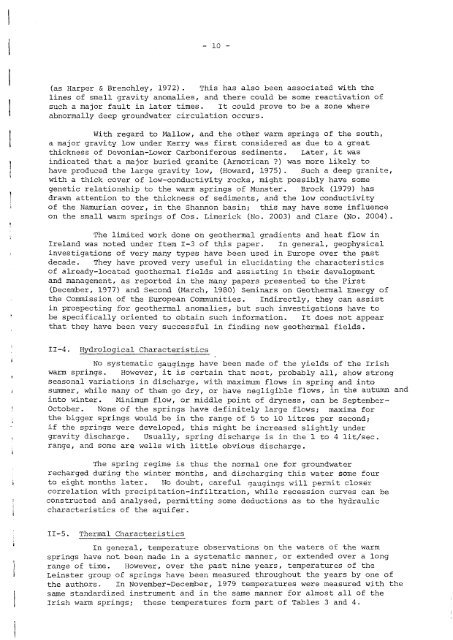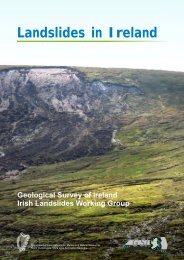Hydrogeothermal Conditions in Ãire - Geological Survey of Ireland
Hydrogeothermal Conditions in Ãire - Geological Survey of Ireland
Hydrogeothermal Conditions in Ãire - Geological Survey of Ireland
You also want an ePaper? Increase the reach of your titles
YUMPU automatically turns print PDFs into web optimized ePapers that Google loves.
- 10 -Cas Harper & Brenchley, 1972). 'I'his has also been associated with thel<strong>in</strong>es <strong>of</strong> small gravity anomalies, and there could be some reactivation <strong>of</strong>such a major fault <strong>in</strong> later times. It could prove to be a zone whereabnormally deep groundwater circulation occurs.With regard to Mallow, and the other warm spr<strong>in</strong>gs <strong>of</strong> the south,a major gravity low under Kerry was first considered as due to a greatthickness <strong>of</strong> Devonian-Lower Carboniferous sediments. Later, it was<strong>in</strong>dicated that a major buried granite (Armorican ?) was more likely tohave produced the large gravity low, (Howard, 1975). Such a deep granite,with a thick cover <strong>of</strong> low-conductivity rocks, might possibly have somegenetic relationship to the warm spr<strong>in</strong>gs <strong>of</strong> Munster. Brock (1979) hasdrawn attention to the thickness <strong>of</strong> sediments, and the low conductivity<strong>of</strong> the Namurian cover, <strong>in</strong> the Shannon bas<strong>in</strong>; this may have some <strong>in</strong>fluenceon the small warm spr<strong>in</strong>gs <strong>of</strong> Cos. Limerick (No. 2003) and Clare (No. 2004).The limited work done on geothermal gradients and heat flow <strong>in</strong><strong>Ireland</strong> was noted under Item 1-3 <strong>of</strong> this paper. In general, geophysical<strong>in</strong>vestigations <strong>of</strong> very many types have been used <strong>in</strong> Europe over the pastdecade. They have proved very useful <strong>in</strong> elucidat<strong>in</strong>g the characteristics<strong>of</strong> already-located geotherw~l fields and assist<strong>in</strong>g <strong>in</strong> their developmentand management, as reported <strong>in</strong> the many papers presented to the First(December, 1977) and Second (March, 1980) Sem<strong>in</strong>ars on Geothermal Energy <strong>of</strong>the commission <strong>of</strong> the European Communities. Indirectly, they can assist<strong>in</strong> prospect<strong>in</strong>g for geothermal anomalies, but such <strong>in</strong>vestigations have tobe specifically oriented to obta<strong>in</strong> such <strong>in</strong>formation. It does not appearthat they have been very successful <strong>in</strong> f<strong>in</strong>d<strong>in</strong>g new geothermal fields.11-4. Hydrological CharacteristicsNo systematic gaug<strong>in</strong>gs have been made <strong>of</strong> the yields <strong>of</strong> the Irishwarm spr<strong>in</strong>gs. However, it is certa<strong>in</strong> that most, probably all, show strongseasonal variations <strong>in</strong> discharge, with maximum flows <strong>in</strong> spr<strong>in</strong>g and <strong>in</strong>tosummer, while many <strong>of</strong> them go dry, or have negligible flows, <strong>in</strong> the autumn and<strong>in</strong>to w<strong>in</strong>ter. M<strong>in</strong>imum flow, or middle po<strong>in</strong>t <strong>of</strong> dryness, can be SeptemberOctober. None <strong>of</strong> the spr<strong>in</strong>gs have def<strong>in</strong>itely large flows; maxima forthe bigger spr<strong>in</strong>gs would be <strong>in</strong> the range <strong>of</strong> 5 to 10 litres per second;if the spr<strong>in</strong>gs were developed, this might be <strong>in</strong>creased slightly undergravity discharge. Usually, spr<strong>in</strong>g discharge is <strong>in</strong> the 1 to 4 lit/sec.range, and some are wells with little obvious discharge.The spr<strong>in</strong>g regime is thus the normal one for groundwaterrecharged dur<strong>in</strong>g the w<strong>in</strong>ter months, and discharg<strong>in</strong>g this water some fourto eight months later. No doubt, careful gaug<strong>in</strong>gs will permit closercorrelation wie1 precipitation-<strong>in</strong>filtration, while recession curves can beconstructed and analysed, permitt<strong>in</strong>g some deductions as to the hydrauliccharacteristics <strong>of</strong> the aquifer.11-5. Thermal CharacteristicsIn general, temperature observations on the waters <strong>of</strong> the warmspr<strong>in</strong>gs have not been made <strong>in</strong> a systematic manner, or extended over a longrange <strong>of</strong> time. However, over the past n<strong>in</strong>e years, temperatures <strong>of</strong> theLe<strong>in</strong>ster group <strong>of</strong> spr<strong>in</strong>gs have been measured throughout the years by one <strong>of</strong>the authors. In November-December, 1979 temperatures were measured with thesame standardized <strong>in</strong>strument and <strong>in</strong> the same manner for almost all <strong>of</strong> theIrish warm spr<strong>in</strong>gs; these temperatures form part <strong>of</strong> Tables 3 and 4.
















